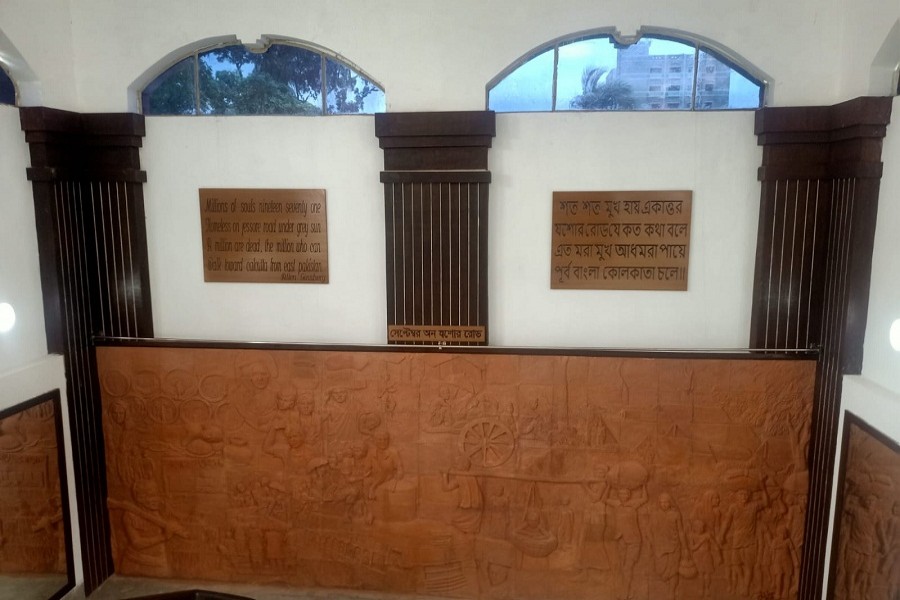Millions of souls nineteen seventy one
homeless on Jessore road under gray sun
A million are dead, the million who can
Walk toward Calcutta from East Pakistan
- Allen Ginsberg, American poet and activist
November 14, 1971. A poem was published in The New York Times; it sang the wails of insufferable plights and woes of the then East Pakistan refugees' journey to the Refugee Camps and their states. Ginsberg wrote the poem after visiting the refugee camps along the Jessore Road in West Bengal.
Ginsberg's poem was a maskless representation of the actual plight that the people suffered. The sickness and squalor of the people in the refugee camps and the inhumane living conditions there are narrated descriptively in this poem.
After 51 years of independence, September on Jessore Road has crawled out of its form in ink and paper and taken a separate art form to let today's generation know the story. The art form is Terracotta, and it now stands in Jessore.
Md. Mizanur Rahaman, a fine artist, has his artistic skills instilled in this terracotta mural installed in the Jessore Collectorate Office. Being a government establishment, the idea was a joint initiative by the officials and the artist executing the 22.5' × 8' terracotta wall piece.
Tomizul Islam, DC (Jessore), took the primary initiative. The DC and ADC (General) of Jessore wanted a piece that would honour Allen Ginsberg's poem that speaks about Jessore Road.
The artist presented the concept and started working on the design layout midway through this year. The primary idea was based on wood carving, but it was replaced with Terracotta for a firmer look and longevity. The final layout was a result of many trials and presentations. After the final design got the green signal, the magic of turning words into burnt clay inscriptions started in a factory at Tongi.
What is Terracotta?
Terracotta is the art of creating glazed or unglazed porous earthenware, figurines, and other decorative materials from clay which is dried and fired in temperatures of around 1000°C, giving it a distinctly orange or burnt red colour.
This colour depends not only on the type of clay but also on the firing process. Decorative pieces are either left with their original colour or painted in multiple hues to make them more attractive.
Art, artistry and Terracotta
The terracotta mural represents the scenarios described in the poem - the plight of the refugees and the insufferable journey towards an unknown tomorrow. Even the faces depicted in the mural are natural, filled with humane emotions that give the viewers a momentary illusion of a living object. The burnt red and orange hues, with mild touches from brushes by the artist, make it look more lively. The elegance of Terracotta compels the viewer to keep searching for elements in the clay curving genius.

Artist Md. Mizanur Rahaman, who turned the words into painting, shared his experience working on the piece with the Financial Express.
"Art is what feeds the mind. Especially when we are to present one art form in the face of another, we try our best to preserve the original message inscribed in it."
"The poem speaks of the suffering of the refugees on the flight, their fear, sadness, helplessness, and terror. The mural has been retouched again and again to get the emotions reflected as best we could portray," he added.
The 22.5 feet wide terracotta mural has been placed in the Jessore Collectorate building. Four lines from Ginsberg's poem are curved in wooden placards in Both English and Bengali (translated) and placed above the mural. As Allen Ginsberg's poem is the inspiration for this mural, the poem's name is also placed above the beautiful art piece.
The mural is an analogy of individual stories of the refugee camps, which came together in one frame, just like Ginsberg's poem. The people rushing towards the camps on foot, elderlies in ramshackle bamboo cradles, children suffering from severe malnutrition, the overcrowded buses, and the pipes - in short, glimpses of the refugee situation are portrayed here.
The mural was inaugurated on September 10, 2022, by the Minister of Social Welfare Nuruzzaman Ahmed and MP Kazi Nabil Ahmed (Jessore-3) in the presence of Dr Abu Saleh Mostafa Kamal, the Director-General of the Department of Social Services, Zillur Rahman Chowdhury, Divisional Commissioner, Khulna, and many respectable faces.
About the artist
Artist Md. Mizanur Rahman graduated from the Department of Fine Arts at the University of Chittagong. He has been doing interior and exterior designing since the early days of his career. His first work in Terracotta came in 2008, in a duplex house at Nikunja Residential Area. For a long time, he has used Terracotta as a statement interior and exterior as his preferred design style. Though he also uses other artistry forms in his design approach, he preferred Terracotta in this mural.

Mr Mizan accomplished the project with young artist Jayashish and his team. About doing the mural, he said, "To be able to work on a project that is a record of the history of the liberation war, that reminds us of the struggles that our people had to go through and portraying that on a mural - is an honour for me."
"I think the mural being inaugurated in September and the location being Jessore make the mural even more significant," he concluded.


